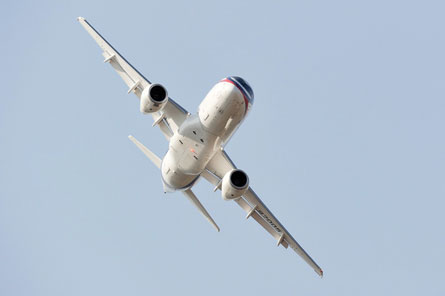Photos of the first serially produced Sukhoi Superjet 100 on a snowy runway in Komsomolsk-on-Amur were inauspicious. And questions persist over the technical performance of the regional jet. But there is no denying that first delivery - albeit belated - represents a major milestone not just in the life of the programme, but for Russian aerospace ambitions more generally.
The Superjet 100, previously the Russian Regional Jet, heralded a sea change in the nation's aircraft manufacturing philosophy. Burdened with the Russian reputation for producing agricultural aircraft that lacked adequate after-market support, Sukhoi elected to enlist Western partners from an early stage, joining forces with Alenia to market the type under the SuperJet International banner and leveraging the expertise of engine manufacturer Snecma via the PowerJet consortium. With Italian design company Pininfarina engaged to develop optional interiors for the type, the message was clear: this was an aircraft geared toward markets far beyond Russia's borders.
 |
|---|
©Superjet InternationalBetter late than never |
Winning critical Western endorsements has of course proved problematic. An order from little-known ItAli Airlines came and went; a letter of intent signed by Hungary's Malév was "frozen". And a blow was delivered late last year when Alitalia backed away, citing concerns that the aircraft - first delivery of which was once due in November 2008 - had still to enter service.
But with Armavia now ready to deploy the aircraft on its Yerevan-Moscow route, that objection has at least been removed - and the obsession with past delays can fade. They are, after all, endemic to new aircraft programmes, as Boeing's ongoing 787 travails.
For airlines, the Superjet is now a reality, a differentiator for as long as other new programmes around the world - Bombardier's CSeries airliner, China's C919, et al - remain mired in the thorny development stage.
Obstacles must still be overcome, of course. Sukhoi admits a gap between actual and promised cruise fuel burn. Aeroflot is said to seek sanctions on Sukhoi. And the crucial Western breakthrough is still awaited.
But with delivery of the first aircraft - delays to which at least allowed it to be topically named Yuri Gagarin, just after the 50th anniversary of the first manned spaceflight - the Superjet 100 has achieved more than fierce early detractors expected. And for all Sukhoi's ongoing headaches, the searing scrutiny to which new Airbus and Boeing aircraft are subject offers a hope: that being the underdog might have its advantages.
Source: Flight International






















